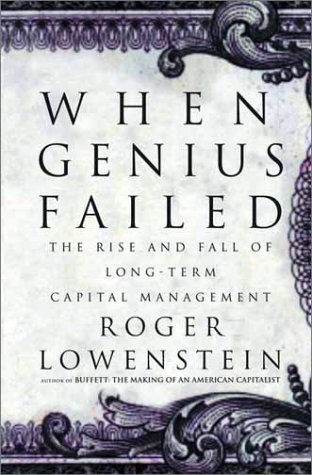More on this book
Community
Kindle Notes & Highlights
Steinhardt blamed his losses on a sudden evaporation of “liquidity,” a term that would be on Long-Term’s lips in years to come.5 But “liquidity” is a straw man. Whenever markets plunge, investors are stunned to find that there are not enough buyers to go around. As Keynes observed, there cannot be “liquidity” for the community as a whole.6 The mistake is in thinking that markets have a duty to stay liquid or that buyers will always be present to accommodate sellers. The real culprit in 1994 was leverage. If you aren’t in debt, you can’t go broke and can’t be made to sell, in which case
...more
aren’t in debt, you can’t go broke and can’t be made to sell, in which case “liquidity” is irrelevant. But a leveraged firm may be forced to sell, lest fast-accumulating losses put it out of business. Leverage always gives rise to this same brutal dynamic, and its dangers cannot be stressed too often.
of $10 million and more. Weill and his top lieutenant, Jamie Dimon, were hostile to the star system pioneered by Hilibrand, under which
traders at Salomon (now Salomon Smith Barney) took home a percentage of their profits. Since the traders were not penalized for losses, they had a perverse incentive to bet as much of the company’s money as they could. Essentially, Weill and
bankruptcy filing by Drexel Burnham Lambert, the junk-bond king, had actually eased the panic in junk bonds.
months after it.13 His Neolithic opposition to enhanced disclosure—which, because it allows investors to be their own watchdogs, is ever the best friend of free capital markets—served to remind one of the early Greenspan who (in thrall to Ayn Rand) once wrote, “The basis of regulation is armed force.”14 In fact, it is in countries that lack transparency (such as Rus-sia) that markets need to be defended by soldiers.
remain. As the use of derivatives grows, this deficiency will return to haunt us.
Long-Term debacle. Its report concluded, “The central public policy issue raised by the LTCM episode is how to constrain excessive leverage more effectively.” Moreover, it recognized the growing role of derivatives, noting, “Balance-sheet leverage by itself is not an adequate measure of risk.”15 However, the report
Street history, the fund had blazed across the financial skies like a luminous rocket, a half-man, half-machine that seemingly reduced an uncertain world to rigorous, cold-blooded odds. Like visitors from a remote future, the professors seemed to have superseded the random luck and ill fate that had ever lurked in the shadows of markets.
As with an insurer who collects heady premiums but gives them back when a big storm hits, Long-Term’s profits were not, in a sense, all “earned”; in part, they were borrowed against the day when the cycle would turn. No investment—Internet wunderkinds included
investing, but an overrated one. As Keynes noted, one bet soundly considered is preferable to many poorly understood. The Long-Term episode proved that eggs in
the huge leverage implicit in its derivatives book. One can be big (and therefore illiquid); one can (within prudent limits) be leveraged. But the investor who is highly leveraged and illiquid is playing Russian roulette, for he must be right about the market not merely at the end, but every single day. (One wrong day, and he is out of business.) Long-Term was so self-certain
they should. The professors’ conceit was to think that models could forecast the limits of behavior. In fact, the models could tell them what was reasonable or what was predictable based on the past. The professors overlooked the fact that people, traders included, are not always reasonable. This is the true lesson of Long-Term’s demise. No matter what the models say, traders are not machines guided by silicon chips; they are impressionable and imitative; they run in flocks and retreat in hordes.
Unfortunately, uncertainty, as opposed to risk, is an indefinite condition, one that does not conform to numerical straitjackets.


